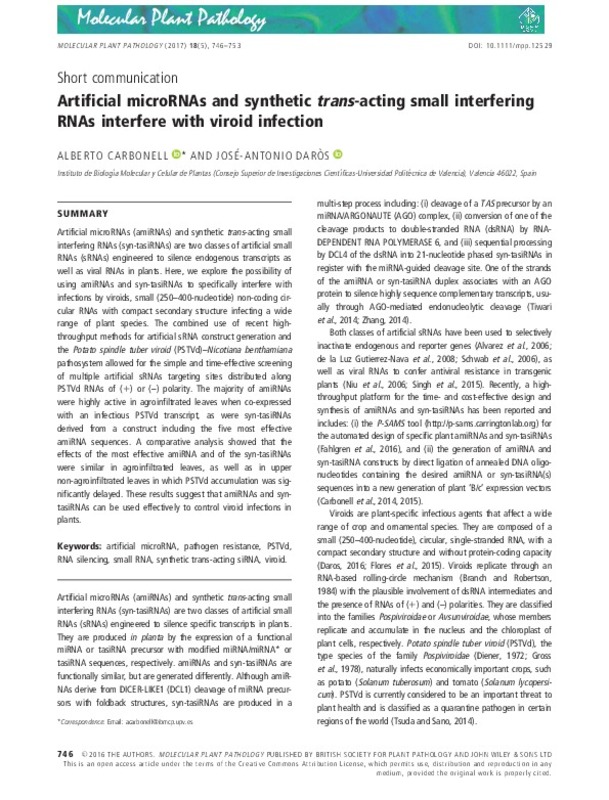JavaScript is disabled for your browser. Some features of this site may not work without it.
Buscar en RiuNet
Listar
Mi cuenta
Estadísticas
Ayuda RiuNet
Admin. UPV
Artificial microRNAs and synthetic trans-acting small interfering RNAs interfere with viroid infection
Mostrar el registro sencillo del ítem
Ficheros en el ítem
| dc.contributor.author | Carbonell Olivares, Alberto
|
es_ES |
| dc.contributor.author | Daros Arnau, Jose Antonio
|
es_ES |
| dc.date.accessioned | 2017-06-07T12:24:45Z | |
| dc.date.available | 2017-06-07T12:24:45Z | |
| dc.date.issued | 2016 | |
| dc.identifier.issn | 1464-6722 | |
| dc.identifier.uri | http://hdl.handle.net/10251/82517 | |
| dc.description.abstract | [EN] Artificial microRNAs (amiRNAs) and synthetic trans-acting small interfering RNAs (syn-tasiRNAs) are two classes of artificial small RNAs (sRNAs) engineered to silence endogenous transcripts as well as viral RNAs in plants. Here, we explore the possibility of using amiRNAs and syn-tasiRNAs to specifically interfere with infections by viroids, small (250–400-nucleotide) non-coding circular RNAs with compact secondary structure infecting a wide range of plant species. The combined use of recent highthroughput methods for artificial sRNA construct generation and the Potato spindle tuber viroid (PSTVd)–Nicotiana benthamiana pathosystem allowed for the simple and time-effective screening of multiple artificial sRNAs targeting sites distributed along PSTVd RNAs of (1) or (–) polarity. The majority of amiRNAs were highly active in agroinfiltrated leaves when co-expressed with an infectious PSTVd transcript, as were syn-tasiRNAs derived from a construct including the five most effective amiRNA sequences. A comparative analysis showed that the effects of the most effective amiRNA and of the syn-tasiRNAs were similar in agroinfiltrated leaves, as well as in upper non-agroinfiltrated leaves in which PSTVd accumulation was significantly delayed. These results suggest that amiRNAs and syntasiRNAs can be used effectively to control viroid infections in plants. | es_ES |
| dc.description.sponsorship | We thank Veronica Aragones, Teresa Cordero, Arnau Puigvert and Cristina Beceiro for invaluable technical assistance. This study was supported by grants BIO2014-54269-R and AGL2013-49919-EXP from the Ministerio de Economia y Competitividad (MINECO, Spain). Alberto Carbonell was supported by an Individual Fellowship from the European Union's Horizon 2020 research and innovation programme under the Marie Sklodowska Curie grant agreement No. 655841. | en_EN |
| dc.language | Inglés | es_ES |
| dc.publisher | Wiley | es_ES |
| dc.relation.ispartof | Molecular Plant Pathology | es_ES |
| dc.rights | Reconocimiento (by) | es_ES |
| dc.subject | Artificial microRNA | es_ES |
| dc.subject | Pathogen resistance | es_ES |
| dc.subject | PSTVd | es_ES |
| dc.subject | RNA silencing | es_ES |
| dc.subject | Small RNA | es_ES |
| dc.subject | Synthetic trans-acting siRNA | es_ES |
| dc.subject | Viroid | es_ES |
| dc.title | Artificial microRNAs and synthetic trans-acting small interfering RNAs interfere with viroid infection | es_ES |
| dc.type | Artículo | es_ES |
| dc.identifier.doi | 10.1111/mpp.12529 | |
| dc.relation.projectID | info:eu-repo/grantAgreement/EC/H2020/655841/EU/Genome-wide analysis of RNA and protein interacting profiles during a plant virus infection/ | en_EN |
| dc.rights.accessRights | Abierto | es_ES |
| dc.contributor.affiliation | Universitat Politècnica de València. Instituto Universitario Mixto de Biología Molecular y Celular de Plantas - Institut Universitari Mixt de Biologia Molecular i Cel·lular de Plantes | es_ES |
| dc.description.bibliographicCitation | Carbonell Olivares, A.; Daros Arnau, JA. (2016). Artificial microRNAs and synthetic trans-acting small interfering RNAs interfere with viroid infection. Molecular Plant Pathology. 18(5):746-753. https://doi.org/10.1111/mpp.12529 | es_ES |
| dc.description.accrualMethod | S | es_ES |
| dc.relation.publisherversion | http://doi.org/10.1111/mpp.12529 | es_ES |
| dc.description.upvformatpinicio | 746 | es_ES |
| dc.description.upvformatpfin | 753 | es_ES |
| dc.type.version | info:eu-repo/semantics/publishedVersion | es_ES |
| dc.description.volume | 18 | es_ES |
| dc.description.issue | 5 | es_ES |
| dc.relation.senia | 331948 | es_ES |
| dc.identifier.pmid | 28026103 | en_EN |
| dc.identifier.pmcid | PMC6638287 | en_EN |








